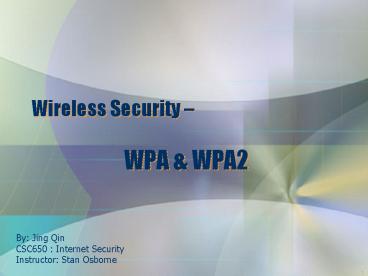Wireless Security WPA - PowerPoint PPT Presentation
1 / 10
Title:
Wireless Security WPA
Description:
Message packet uses the RC4 encryption algorithm, a stream cipher. ... Encryption Algorithm of WEP. 4. Some ... Uses the Advanced Encryption Standard (AES) ... – PowerPoint PPT presentation
Number of Views:1102
Avg rating:3.0/5.0
Title: Wireless Security WPA
1
Wireless Security
WPA WPA2
By Jing QinCSC650 Internet SecurityInstructor
Stan Osborne
2
What is WPA WPA2 - Wi-Fi Protected Access
- WPA was created by The Wi-Fi Alliance in late
2002. - WPA implements a subset of IEEE 802.11i
standard - WPA2 implements a full IEEE 802.11i standard
- They solved all of WEPs known vulnerabilities.
3
Wired Equivalent Privacy ( WEP )
Encryption Algorithm of WEP
- WEP uses a 40-bit static shared key.
- Message packet uses the RC4 encryption algorithm,
a stream cipher. - WEP includes a 24 bits Initialization Vector (IV)
in each message packet. - RC4 key of a packet WEP Key IV
- 64 bit
40 bit 24 bit
4
Some Serious Weaknesses of WEP
- All clients network cards and APs share a single,
static WEP Key. - Lack of automated key management contributes to
infinite static key lifespan in large networks. - The 24 bit IV is too small - every 4096 packets,
two will share the same IV. - Keys can be recovered with easily available
utilities - Weak keys expose the network to attacks or
passive - monitoring
- When WEP was available it was not always turned
on
5
Wi-Fi Protected Access (WPA)
- WPA is intended to be
- Interim short-term replacement for WEP
- A software/firmware upgrade to existing
access - points.
- Inexpensive in terms of time and cost to
implement. - Suitable for enterprise, small sites,
home networks.
6
Two modes of WPA
- Enterprise Mode (WPA)
- Requires an authentication server
- Uses RADIUS protocols for authentication and
key distribution - Centralizes management of user credentials
- Pre-Shared Key Mode (WPA-PSK)
- Does not require authentication server
- Shared Secret (passphrase) is used for
authentication to access point
7
How WPA Addresses the WEP Vulnerabilities
- WPA wraps RC4 cipher engine in four new
algorithms - Extends to 128 bit WEP Key.
- Extends to 48-bit IV and add IV Sequencing Rules
- 3. Temporal Key Integrity Protocol (TKIP)
generates and dynamically changes per-packet
keys. - 4. A Message Integrity Code (MIC) - Michael
8
Wi-Fi Protected Access 2 (WPA2)
- Uses the Advanced Encryption Standard (AES)
- AES selected by National Institute of
Standards and - Technology (NIST) as replacement for DES
- Symmetric-key block cipher using 128-bit
keys - Generates CCM Protocol (CCMP) - Cipher Block
Chaining Message Authentication Code Protocol) - CCMP CTR CBC MAC
- Hardware accelerated and will require replacement
of most APs. - Certified equipment due in late 2004
Cipher Block Chaining/ Message Authentication
Code
Counter Mode Encryption
9
Encryption Method Comparison
Extensible Authentication Protocol
10
Conclusions
- WPA resolves all of WEPs known weaknesses
- WPA provides an enterprise-class security
solution for user authentication and encryption - WPA is a subset of the 802.11i draft standard and
is expected to maintain forward compatibility
with the standard - WPA 2 will provide an even stronger cryptographic
cipher than WPA - Unless there is a significant flaw found in WPA
or RC4 is broken, there may be no reason to move
to WPA 2/AES in the near future































